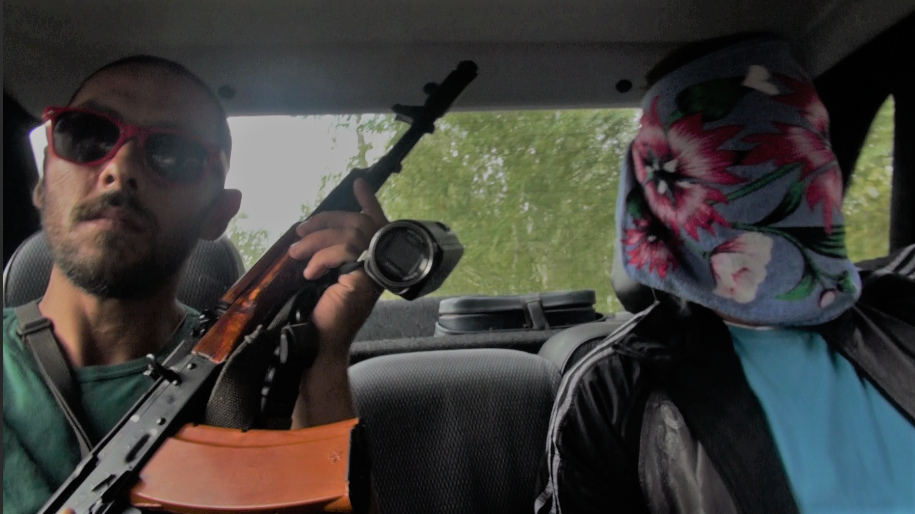Perhaps the biggest surprise of this year’s Open City Documentary Festival – a five-day, under-the-radar gem situated in the heart of London, and dedicated to championing nonfiction work as an art – was that my favorite film of the fest actually ended up taking top prize. Beata Bubenec’s Flight of a Bullet never garnered the sort of buzz during its premiere at True/False that it did over in Europe. (Thankfully, perhaps, as the Russian director faced not only death threats, but also protests and a gas attack by ultra-nationalists when it showed at Moscow’s Artdocfest).
Nevertheless, the Open City Award rightfully went to this courageous female filmmaker, who shot hundreds of hours of footage while embedded with Ukraine’s volunteer military forces (known as Aidar) in their battle against the Russia-backed separatists in Donbass. (And considering her portrayal of these macho men doesn’t shy away from their often-thuggish tactics, I can only imagine what outrage it might have caused had it played Docudays in Kiev!) Filmed in one single, nail-biting take, Flight of a Bullet is also notable for being a war doc in which the war is an off-camera character – ever-present but never front-and-center. No running-and-gunning to be seen.
Instead we bear witness to daily occurrences on the front line, which only grow more and more surreal as the film progresses. As a way of explaining her 80-minute, continuous shot, Bubenec opens with the following white words on black: “Life lasted only while the camera was on, so I kept it rolling.” And indeed this is no gimmick. The cut-less, unfolding-in-real-time aspect is essential to the film’s edge-of-your-seat feel. It’s crucial to experiencing the haphazard reality of war.
Bubenec’s first scene takes place on a bombed out bridge. After assessing the massive damage alongside a sunglasses-wearing, videotaping dude, her lens captures farmers rolling bags of various vegetables on a cart. And random citizens crossing via the fragment that’s still standing – stepping and even cycling around, shrugging off the debris. Life goes on. Out of nowhere a masked soldier starts making trouble, then takes a guy (who comes to the defense of another man who questions why they’re filming) into custody. Only at this point do we realize that Bubenec is tagging along with a ragtag unit of Ukrainian soldiers who probably respect the Geneva Conventions as much as they do Putin.
Nonetheless, the filmmaker is now firmly part of her film – another off-screen character whose presence is forever felt. Back at base, she rushes camera in hand to find help for the man dubiously detained (who is now being taken to a basement for interrogation), pleading to other soldiers. Once downstairs, Bubenec’s lens remains steady on the guy wearing shades as he explains, somewhat absurdly, to the nervous detainee that the filmmaker is “developing a special ops mission video.” Even more absurdly (perhaps because they aren’t officially trained, or perhaps they just don’t think they’ll ever be held to account) these Ukrainian fighters let Bubenec stay and keep on shooting – even as they decide that they will have to conscript the poor fellow to “prove” he’s not a separatist.
And as the befuddled prisoner tries to explain his situation – he’s a pro-Ukraine family man just trying to live his life in a separatist town – things only get weirder. At the prompting of the soldiers he starts to dispense advice on how to take his village, even sketching out possibilities with chalk on a blackboard. It’s at this juncture that Flight of a Bullet practically turns into an existential stage piece – as the man and his masked captor begin to strategize together.
And Bubenec just goes on filming, even as the detainee is driven away and she runs into another soldier – a cigarette-smoking dude wearing nothing but shorts, berating his girlfriend on the phone. He barely notices that he’s being filmed as he bitches about her “not fucking caring” about him – then swears that he’ll “come back and beat the shit” out of her. She continues shooting even as another guy drifts into the frame right as the misogynist exits, adding to the unnerving sense of watching some highly choreographed play. When the misogynist returns she simply follows him. But then suddenly another soldier with a gun beckons, so she goes that way. And that’s when things get downright scary. Nonchalantly, he says he’s taking her to the basement. And that he hopes she’s wearing lace underwear.
Is the soldier sadistically joking when he tells Bubenec that he’s bringing her downstairs to “make love”? It’s a heart-stopping moment – and one that only gets more fraught as we hear the director off-camera, giggling while she tries desperately to figure a way out. “My commander is afraid that I’ll shoot everyone here,” the misogynist says into his phone as her camera once again turns his way. Ultimately, Flight of a Bullet is less a war doc without the shots than a horror film. A camouflaged monster lurking in every frame.

